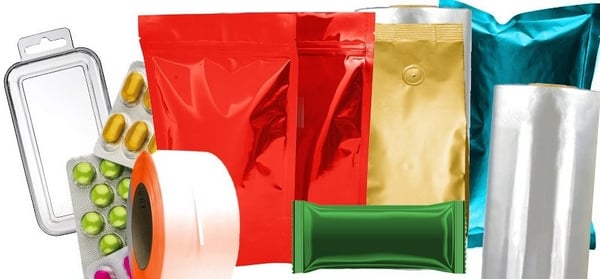Flexible Packaging VS Rigid Packaging: Pros and Cons
Packaging Materials | Environment | Investment | Packaging Design
When it comes to choosing packaging for your products, you have a lot of options. So many that it might be overwhelming to find the perfect packaging. Two broad packaging categories that you will find are flexible packaging and rigid packaging. But, what exactly are the differences between these types of packaging materials?
Some of the main differences include environmental impact, sustainability, cost, and other various items of consideration.
At Industrial Packaging, we pride ourselves on being an educator in the flexible packaging supplies that we offer. However, we want to be clear that for some products rigid packaging is a better choice.
There are also plenty of applications where flexible packaging is the superior choice of the two. In this article, we will compare the pros and cons of flexible and rigid packaging and help you to understand which is a better choice for your specific packaging needs.
What Is Flexible Packaging?
Flexible packaging includes all malleable packaging. Some common examples of flexible packaging include shrink film, stretch film, flexible pouches, seal bands, blister or skin packs, and clamshells. In reality, flexible packaging includes any protective packaging made from materials including plastic, paperboard, paper, foil, wax-coated paperboard, and similar materials, or combinations of these materials.
Flexible packaging supplies such as flexible pouches have taken the global packaging market by storm over the last 5-10 years and continue to expand the world over.

Flexible packaging supplies are gaining quickly on rigid packaging due to their lower expense and lower environmental impact.
Examples of products packaged in flexible packaging supplies include but are not limited to: produce, coffee, meat, fish, poultry, drinks, industrial powders and liquids, electronics, and hundreds of other types of products.
Today, you can find flexible packaging in just about every single supermarket throughout the world.
Pros Of Flexible Packaging Supplies
- Environmentally friendly - Flexible packaging takes up less space in landfills and has the lowest carbon footprint of alternative packaging supplies.
- Easy to use - Flexible packaging generally has less ability to induce wrap-rage and often has "easy open" capabilities such as tear-away lids on flexible pouches.
- Lower cost - Most flexible packaging is less expensive than rigid alternatives.
- Branding and aesthetic capabilities - Flexible packaging such as flexible pouches can be fully printed edge to edge with eye catching graphics.
- Uses less material than rigid packaging - Made with soft plastics and less material.
Cons Of Flexible Packaging
- May affect the flavor of food or liquids
- Low resistance to extreme temperatures
- Difficult to recycle as there isn’t an infrastructure set up to do so
- 1,000+ years to totally degrade in a landfill
Need Help Designing Your Packaging?
What Is Rigid Packaging?
Rigid packaging is packaging that features heavier and often stronger materials than flexible packaging. Forms of rigid packaging materials include but are not limited to: glass, hard plastics, cardboard, metal, and so on. Rigid packaging supplies are usually more expensive than their flexible alternatives and most have significantly higher carbon footprints than flexible packaging.
Some examples of rigid packaging include whip cream cans, pickle jars, hard plastic cannabis containers, yogurt containers, wine bottles and hummus containers.

Rigid packaging is often used when packaging fragile food products that need protection from falling. Think about the hard plastic container of hummus that usually will not break if dropped on the floor.
While some rigid packaging generally ensures the safety of your product, items like glass pickle jars can still break if dropped.
Some types of rigid packaging are used specifically to induce a sense of luxury. In fact, many types of luxury packaging use multiple different types of rigid packaging in one package. For example, fine single malt scotch is often packaged inside of a glass bottle and then a cardboard box or another additional container.
Brands who require superior protection of their products will also often choose rigid packaging because of their often stronger protection capabilities.
Rigid packaging is a popular choice due to the heavy-duty nature and protective qualities of the materials used to make them.
Pros Of Rigid Packaging
- Superior strength - Made from hard plastics and other materials.
- Gives an impression of quality - Glass for example suggests luxury.
- Unlikely to affect the flavor of food - This is due to the lack of soft plastics.
- Often made from easy to recycle materials - For example, glass and hard plastic.
Cons Of Rigid Packaging
- Notably more expensive in most cases
- Significantly higher carbon footprint
- Much higher shipping costs
- If not recycled, takes up more space in landfills
Which Type Of Packaging Should You Choose?
When deciding on which type of packaging supply is right for your business, you will want to ask yourself a few questions and consider the answers carefully.
- Do you need superior product protection? If so, rigid packaging may be the best choice (although glass may not be).
- Is the environmental impact of your packaging important to you or your customers? If you answered yes, you will want to consider flexible packaging. Despite the fact most flexible packaging is not recyclable, it has a much lower carbon footprint and still results in less pollution overall.
- Are you looking to reduce the cost of your packaging? If that is the case, flexible packaging is the better choice.
- Is your brand looking to express ultra high quality or luxury? If yes, then rigid packaging would be the best choice for your needs.
- Are you looking to keep the cost of shipping down? If you are, flexible packaging is a more sensible choice.
Once you have answered these questions, you should be able to form a pretty solid idea about which type of packaging is the best choice for you. If however you are still unsure about how to proceed or would like assistance in choosing the proper packaging supplies, feel free to contact one of our packaging experts.
They will be able to help you better understand the elements of flexible packaging vs rigid packaging and will also be able to help you choose an appropriate vendor, even it that means it is not us.
About Nathan Dube
As the Digital Marketing Specialist at Industrial Packaging, I am honored to create content for such a phenomenal company and work with one of the greatest teams in the Packaging Industry. Whether creating a video, writing blog posts or generating other pieces of content and multimedia, I am always excited to help educate and inspire our prospects and clients to reach their highest potential in regards to their packaging processes and needs.




